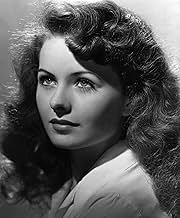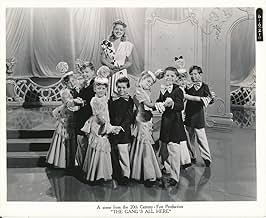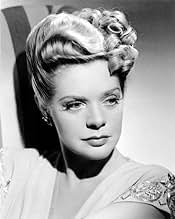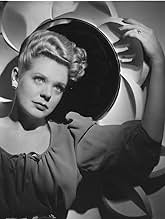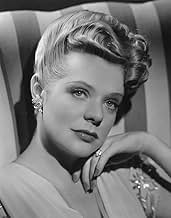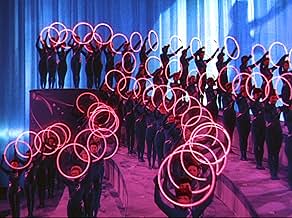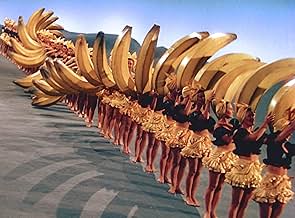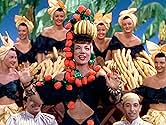AVALIAÇÃO DA IMDb
6,6/10
2,2 mil
SUA AVALIAÇÃO
Adicionar um enredo no seu idiomaA soldier falls for a chorus girl and then experiences trouble when he is posted to the Pacific.A soldier falls for a chorus girl and then experiences trouble when he is posted to the Pacific.A soldier falls for a chorus girl and then experiences trouble when he is posted to the Pacific.
- Direção
- Roteiristas
- Artistas
- Indicado a 1 Oscar
- 2 vitórias e 1 indicação no total
Benny Goodman and His Orchestra
- Benny Goodman's Orchestra
- (as Benny Goodman Orchestra)
Don Anderson
- Club New Yorker Patron
- (não creditado)
Leon Belasco
- Waiter
- (não creditado)
Brooks Benedict
- Club New Yorker Patron
- (não creditado)
Lee Bennett
- Club New Yorker Patron
- (não creditado)
William A. Boardway
- Club New Yorker Patron
- (não creditado)
Avaliações em destaque
It was called "The Girls He Left Behind", when first released in Britain in 1944. In this movie I think Busby Berkeley reached the pinnacle. It was his finest effort. Carmen Miranda, wearing that tutti frutty hat was a mouth-watering revelation; along with her ability to murder the English language. Roly poly Eugene Palette, trying to get the worrisome Edward Everett Horton's mind off his wife. Handing their hats to the hat-check girl, who was the lovely June Haver. (If you blinked you would have missed her). Alice Faye? A dream in Technicolour. James Ellison in the leading romantic role. Where was John Payne? He was the usual romantic lead in these Twentieth Century Fox musical capers of the early nineteen-forties.
Weak plot? Who the hell really cared! The Benny Goodman Orchestra; those songs, and the rich Technicolour, plus the Lanky Charlotte Greenwood, blindly reaching for the telephone and answering with the cat instead, brightened this teen-aged English boy's life in those wartime years of long ago. I have watched it on television more than once. The big question though. Why oh why, has it not been released on video or, better still, DVD? Can anyone explain?
Weak plot? Who the hell really cared! The Benny Goodman Orchestra; those songs, and the rich Technicolour, plus the Lanky Charlotte Greenwood, blindly reaching for the telephone and answering with the cat instead, brightened this teen-aged English boy's life in those wartime years of long ago. I have watched it on television more than once. The big question though. Why oh why, has it not been released on video or, better still, DVD? Can anyone explain?
No doubt about it, the movie's a cast of characters collected in someone's goofy heaven—Carmen Miranda, Busby Berkeley, and Edward Everett Horton, all together in one padded cell. Throw in leggy Charlotte Greenwood and froggy Eugene Palette, and there's enough colorful types for ten musicals. Aside from the conventional plot, this 1943 trip to bizzaroland doesn't disappoint for sheer wackiness.
Of course, there's Miranda's infamous arching bananas replete with the recumbent girls, all of which could have sent Dr. Freud into terminal overload. Really, how the carnally obsessed Berkeley managed to stay this side of the censor is still puzzling. And catch that final number with the disembodied heads and Palette croaking out a song. I'm just wondering what Berkeley's dreams were like. They couldn't be any weirder than what's there on the screen.
Then there's the top of Miranda's head sporting more pointy architecture than the Manhattan skyline. And catch her wardrobe—somewhere there's a dozen circus clowns without their costumes. After that, add a few lines of her hilariously fractured English, and she's a whole wonderful show in herself. Too bad her personal life was apparently so unhappy.
Great color photography, along with a soulful Alice Faye. Even the pretty much unknown James Ellison seems a good stand-in for the boys in uniform. No doubt about it, Hollywood knew how to concoct lively and engaging wartime shows. But just as importantly, these concoctions still entertain decades later, even with an inspired lunatic like Busby Berkeley in charge.
Of course, there's Miranda's infamous arching bananas replete with the recumbent girls, all of which could have sent Dr. Freud into terminal overload. Really, how the carnally obsessed Berkeley managed to stay this side of the censor is still puzzling. And catch that final number with the disembodied heads and Palette croaking out a song. I'm just wondering what Berkeley's dreams were like. They couldn't be any weirder than what's there on the screen.
Then there's the top of Miranda's head sporting more pointy architecture than the Manhattan skyline. And catch her wardrobe—somewhere there's a dozen circus clowns without their costumes. After that, add a few lines of her hilariously fractured English, and she's a whole wonderful show in herself. Too bad her personal life was apparently so unhappy.
Great color photography, along with a soulful Alice Faye. Even the pretty much unknown James Ellison seems a good stand-in for the boys in uniform. No doubt about it, Hollywood knew how to concoct lively and engaging wartime shows. But just as importantly, these concoctions still entertain decades later, even with an inspired lunatic like Busby Berkeley in charge.
20th Century Fox pulled out all the stops for this Technicolor musical, "The Gang's All Here," directed by Busby Berkeley. There is a song at least every few minutes, wonderful singing, dancing, and comedy galore, and an absolutely threadbare plot. The story is of no consequence - the music is the thing, along with Carmen Miranda's gaudily-costumed numbers and delightful butchering of the English language.
This film was made to bolster spirits during the war and to sell war bonds, which is dealt with in part of the plot. I can't imagine anyone walking out of the theater with anything but a smile on their face.
Alice Faye is lovely and sings beautifully in her contralto, her main number being "A Journey to a Star." Miranda's big number, of course, is the classic "The Lady in the Tutti Frutti Hat" with the fabulous illusion at the end. Charlotte Greenwood gets to dance in "The Jitters" and she, Edward Everett Horton, and Eugene Palette provide excellent support. Benny Goodman's band is a standout, and I've always been a sucker for Benny's smooth, relaxed singing voice. Busby Berkeley's numbers are spectacular, particularly the finale - but somehow, I can't see it being done on someone's lawn! I agree with one of the posters, these Fox musicals need to be packaged into a collection and put out on DVD. They're too much fun to miss.
This film was made to bolster spirits during the war and to sell war bonds, which is dealt with in part of the plot. I can't imagine anyone walking out of the theater with anything but a smile on their face.
Alice Faye is lovely and sings beautifully in her contralto, her main number being "A Journey to a Star." Miranda's big number, of course, is the classic "The Lady in the Tutti Frutti Hat" with the fabulous illusion at the end. Charlotte Greenwood gets to dance in "The Jitters" and she, Edward Everett Horton, and Eugene Palette provide excellent support. Benny Goodman's band is a standout, and I've always been a sucker for Benny's smooth, relaxed singing voice. Busby Berkeley's numbers are spectacular, particularly the finale - but somehow, I can't see it being done on someone's lawn! I agree with one of the posters, these Fox musicals need to be packaged into a collection and put out on DVD. They're too much fun to miss.
What the other comments thus far seem to say is that this is a fun movie without much story. It has Carmen Miranda and her Tutti Fruity hat and that makes up for a weak, sewn together plot. What they seem to have overlooked is that this film wasn't made in the thirties or fifties, it was produced in the middle of World War II. Yes it has some great Busby Berkeley numbers, but its historical and ideological implications are profound as well.
This was a film whose plot was never meant to suture an audience into a conventional story, it was meant to reassert American ideology during a remarkably difficult time. There are comical references to the "Good Neighbor Policy"- all but forgotten outside history classes. Ultimately, the film endorses American hegemony during the period through the friendly inclusion and references to South and Latin American imports such as coffee and Carmen Miranda. It also reminds the home front that its primary duty is to support the men on the front lines; women should make and keep promises of fidelity, and those who can should contribute money through war bonds, those who can't should contribute sweat equity. THE GANG'S ALL HERE is ultimately a war movie, but it is a movie which assumes American military superiority a priori; rather, it asserts and enforces the notion of a superior American will and character. Perhaps the plot seems dated, but historically and ideologically it is perfectly balanced and constructed.
This was a film whose plot was never meant to suture an audience into a conventional story, it was meant to reassert American ideology during a remarkably difficult time. There are comical references to the "Good Neighbor Policy"- all but forgotten outside history classes. Ultimately, the film endorses American hegemony during the period through the friendly inclusion and references to South and Latin American imports such as coffee and Carmen Miranda. It also reminds the home front that its primary duty is to support the men on the front lines; women should make and keep promises of fidelity, and those who can should contribute money through war bonds, those who can't should contribute sweat equity. THE GANG'S ALL HERE is ultimately a war movie, but it is a movie which assumes American military superiority a priori; rather, it asserts and enforces the notion of a superior American will and character. Perhaps the plot seems dated, but historically and ideologically it is perfectly balanced and constructed.
There are films whose plots are much worse. At least this film has funny moments with Charlotte Greenwood and whenever Carmen Miranda is on the screen.
But this film is a showcase for the two sequences choreographed by Busby Berkeley. Much has been written about them, but watching them never ceases to stimulate and amaze my senses. Berkeley's sense of space is so elastic -- you feel as if he could pan and zoom through miles of space and fill it with people, trees, bananas, anything! I don't think any of his Warner Bros. films used the zoom camera with as much daring (supposedly Carmen Miranda almost got knocked off the painted donkey during rehearsals of "The Lady in the Tutti-Frutti Hat").
What is so special for me in these dance sequences is that the images and music are so well-constructed that you loose interest in following the plot and just revel and enjoy the images. People cease being human forms and become elements of color on a painted canvas, and then resume being human once again. It's all incredibly magical and more abstract than Berkeley had been or was able to achieve in the future. Stunning!
But this film is a showcase for the two sequences choreographed by Busby Berkeley. Much has been written about them, but watching them never ceases to stimulate and amaze my senses. Berkeley's sense of space is so elastic -- you feel as if he could pan and zoom through miles of space and fill it with people, trees, bananas, anything! I don't think any of his Warner Bros. films used the zoom camera with as much daring (supposedly Carmen Miranda almost got knocked off the painted donkey during rehearsals of "The Lady in the Tutti-Frutti Hat").
What is so special for me in these dance sequences is that the images and music are so well-constructed that you loose interest in following the plot and just revel and enjoy the images. People cease being human forms and become elements of color on a painted canvas, and then resume being human once again. It's all incredibly magical and more abstract than Berkeley had been or was able to achieve in the future. Stunning!
Você sabia?
- CuriosidadesThe production number "The Lady In The Tutti-Frutti Hat" ran into problems with the censors. The Hayes office at first considered the way the gigantic bananas were held in front of the dancers as being too "phallic". The problem was resolved by having the dancers hold the bananas at waist level rather than at hip level.
- Erros de gravaçãoIncorrectly regarded as goof: As the passengers disembark the ship within the first 3 minutes of the film, a series of mechanical-looking large shadows can be easily seen moving across the painted backdrop of buildings intended to be far in the distance. This is actually a stage set of a musical production, thus not filmed as a real scene.
- Citações
Phil Baker: Oh, Dorita, you remember Mr. Potter and Mr. Mason.
Dorita: Ah! I remember Mr. Potty. You are here to kick up some more heels, huh?
Peyton Potter: No!
Phil Baker: Mr. Potter wants you to come to his house this weekend.
Dorita: Ah-ah-ah, you naughty boy. You are what they call a fast-work man, yes?
- ConexõesEdited into Homem e Mulher Até Certo Ponto (1970)
- Trilhas sonorasHail! Hail! The Gang's All Here!
(uncredited)
Music by Theodore Morse and Arthur Sullivan
Lyrics by Dolly Morse (as D.A. Esrom)
Sung by a chorus during the opening credits
Principais escolhas
Faça login para avaliar e ver a lista de recomendações personalizadas
- How long is The Gang's All Here?Fornecido pela Alexa
Detalhes
- Tempo de duração1 hora 43 minutos
- Cor
- Proporção
- 1.33 : 1
Contribua para esta página
Sugerir uma alteração ou adicionar conteúdo ausente


